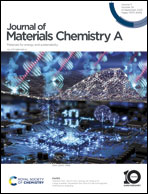High-performance carbon-capture membranes developed by (non)solvent-induced nanostructural rearrangement in Nafion
Abstract
Membrane materials exhibiting high CO2 permeability and selectivity are needed for CO2 capture to mitigate global climate change. In this study, Nafion is dissolved in and cast from N-methylpyrrolidone to generate membranes that are subsequently immersed in liquid water to promote nanostructural rearrangement of this amphiphilic polyelectrolyte. Gas permeability results confirm that the CO2 permeability and CO2/N2 selectivity of the membrane both increase significantly (to 472 Barrer and 61, respectively) after such rearrangement and thus exceed the 2008 Robeson upper bound. Transmission electron microscopy and small-angle X-ray scattering reveal that the nanostructure of Nafion is affected by the different processing routes utilized here. In addition, the influence of water vapor on the permeability of a CO2/N2 mixture at different relative humidity levels has been examined. These results confirm that the morphology and permeability of Nafion membranes are sensitive to water (as vapor or liquid), which enhances CO2 transport. Moreover, our findings indicate that (non)solvent-induced nanostructural rearrangement of amphiphilic polyelectrolytes constitutes a largely unexplored, but facile and effective, strategy with broad prospects to improve the CO2-separation efficacy of carbon-capture polymer membranes.

- This article is part of the themed collections: 2023 Journal of Materials Chemistry A HOT Papers and #MyFirstJMCA


 Please wait while we load your content...
Please wait while we load your content...